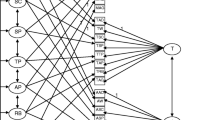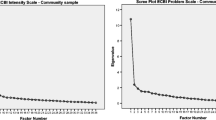Abstract
The present study investigated differences between referred and nonreferred children and their families on the basis of home and clinic observations and parent questionnaires. Subjects were 28 families with children between 4 and 8 years of age who had been referred to a clinic for actingout behavior and 28 nonreferred controls matched on several variables. Home observation results indicated that referred children showed significantly more deviant behavior and less prosocial behavior than nonreferred children and that their parents emitted more negative and commanding behavior in contrast to the control group. Systematic observation in the clinic revealed significant differences only in parent negativeness and number of commands. Finally, all five factors of the parent attitude questionnaire yielded large and significant differences between groups. There was considerable overlap between groups on all behavior variables but less overlap on the parent attitude measure. Results from a stepwise discriminant analysis classified 90% of referred children and 90% of nonreferred children correctly on the basis of the parent attitude variable alone. Taken together, these results suggest that child behavior is not always the critical variable in referral and stress the importance of multiple assessment procedures for child-family problems when children are referred for treatment.
Similar content being viewed by others
Reference notes
Brandon, S.An epidemiological study of maladjustment in childhood. M.D. thesis, University of Durham, 1960.
Shaw, D. A.Family maintenance schedules for deviant behavior. Unpublished doctoral dissertation, University of Oregon, 1971.
Anderson, D.Application of a behavior modification technique to the control of the hyperactive child. Unpublished master's thesis, University of Oregon, 1964.
Ebner, M.An investigation of the role of the social environment in the generalization and persistence of the effect of a behavior modification program. Unpublished doctoral dissertation, University of Oregon, 1967.
Adkins, D. A., & Johnson, S. M.What behaviors may be called deviant for children?A comparison of two approaches to behavior classification. Paper presented at the meeting of the Western Psychological Association, Portland, April 1972.
Skindrud, K.An evaluation of observer bias in experimental-field studies of social interaction. Unpublished doctoral dissertation, University of Oregon, 1972.
Karpowitz, D.Stimulus control in family interaction sequences as observed in the naturalistic setting of the home. Unpublished doctoral dissertation, University of Oregon, 1972.
References
Beakel, N. G., & Mehrabian, A. Inconsistent communications and psychopathology.Journal of Abnormal Psychology, 1969,74, 126–130.
Becker, W. C. The relationship of parental ratings of self and each other to the behavior of kindergarten children as rated by mothers, fathers, and teachers.Journal of Consulting Psychology, 1960,24, 507–527.
Block, J. Parents of schizophrenic, neurotic, asthmatic, and congenitally ill children.Archives of General Psychiatry, 1969,20, 659–674.
Bugental, D. E., Love, L. R., & Kaswan, J. W. Videotaped family interaction: Differences reflecting presence and type of child disturbance.Journal of Abnormal Psychology, 1972,79, 285–290.
Bugental, D. E., Love, L. R., Kaswan, J. W., & April, C. Verbal-nonverbal conflict in parental messages to normal and disturbed children.Journal of Abnormal Psychology, 1971,77, 6–10.
Conners, C. K. Symptom patterns in hyperkinetic, neurotic, and normal children.Child Development, 1970,41, 667–682.
Delfini, L. F., Bernai, M. C., & Rosen, P. M. Comparison of normal and deviant boys in their homes. In L. A. Hamerlynck, L. D. Handy, & E. J. Mash (Eds.),Behavior modification and families. 1. Theory and research. 2. Applications and developments. New York: Brunner Mazel, 1976, in press.
Eberhardy, F. The view from the couch.Journal of Child Psychology and Psychiatry, 1967,8, 257–263.
Eyberg, S. M., & Johnson, S. M. Multiple assessment of behavior modification with families: Effects of contingency contracting and order of treated problems.Journal of Consulting and Clinical Psychology, 1974,42, (4), 594–606.
Haley, J. Marriage therapy.Archives of General Psychiatry, 1963,8, 213–234.
Herbert, E. W., & Baer, D. M. Training parents as behavior modifiers: Self-recording of contingent attention.Journal of Applied Behavioral Analysis, 1972,5, 139–149.
Jenkins, R. L. The varieties of children's behavior problems and family dynamics.American Journal of Psychiatry, 1968,124, 1440–1445.
Johnson, S. M., & Lobitz, G. K. Parental manipulation of child behavior in home observations.Journal of Applied Behavior Analysis, 1974,7, 23–31. (a)
Johnson, S. M., & Lobitz, G. K. The personal and marital adjustment of parents as related to observed child deviance and parenting behaviors.Journal of Abnormal Child Psychology, 1974,2, 193–207. (b)
Johnson, S. M., Wahl, G., Martin, S., & Johansson, S. How deviant is the normal child? A behavioral analysis of the preschool child and his family. In R. D. Rubin, J. P. Brady, & J. D. Henderson (Eds.),Advances in behavior therapy (Vol. 4). New York: Academic Press, 1973. Pp. 37–54.
Kanner, L. Do behavior symptoms always indicate psychopathplogy?Journal of Child Psychology and Psychiatry, 1960,1, 15–25.
Kent, R. N., O'Leary, K. D., Diament, C., & Dietz, A. Expectation biases in observational evaluation of therapeutic change.Journal of Consulting and Clinical Psychology, 1974,42, 774–780.
Kogan, K. I., & Wimberger, H. C. Behavior transactions between disturbed children and their mothers.Psychological Reports, 1971,28, 395–404.
Lobitz, W. C., & Johnson, S. M. Parental manipulation of the behavior of normal and deviant children.Child Development, 1975,46, 719–726.
Miller, L. C., Hampe, E., Barrett, C. L., & Noble, H. Children's deviant behavior within the general population.Journal of Consulting and Clinical Psychology, 1971,37, 16–22.
Novick, J., Rosenfeld, E., Bloch, D., & Dawson, D. Ascertaining deviant behavior in children.Journal of Consulting Psychology, 1966,30, 230–238.
Oleinick, M. S., Bahn, A. K., Eisenberg, L., & Lilienfeld, A. M. Early socialization experiences and intrafamilial environment.Archives of General Psychiatry, 1966,15, 344–353.
Patterson, G. R. The aggressive child: Victim and architect of a coercive system. In L. A. Hamerlynck, L. D. Handy, & E. J. Mash (Eds.),Behavior modification and families. 1. Theory and research. 2. Applications and developments. New York: Brunner Mazel, 1976, in press.
Patterson, G. R., & Cobb, J. A. A dyadic analysis of “aggressive” behaviors. In J. P. Hill (Ed.),Minnesota Symposia on Child Psychology (Vol. 5). Minneapolis: University of Minnesota Press, 1971.
Patterson, G. R., Cobb, J. A., & Ray, R. S. A social engineering technology for retraining of aggressive boys. In H. Adams & L. Unikel (Eds.),Issues and trends in behavior therapy. Springfield, Illinois: Charles C Thomas, 1972.
Patterson, G. R., & Fagot, B. I. Selective responsiveness to social reinforcers and deviant behavior in children.Psychological Record, 1967,17, 369–378.
Patterson, G. R., Ray, R. S., Shaw, D. A., & Cobb, J. A.Manual for coding family interactions, sixth revision, 1969. Available from ASIS National Auxiliary Publications Service, in care of CCM Information Services, Inc., 909 Third Avenue, New York, New York 10022. Document #01234.
Patterson, G. R., & Reid, J. D. Reciprocity and coercion: Two facets of social systems. In C. Neuringer & J. L. Michael (Eds.),Behavior modification in clinical psychology. New York: Appleton-Century-Crofts, 1970.
Raush, H. L., Dittman, A. T., & Taylor, T. J. Person, setting, and change in social interaction.Human Relations, 1959,12, 361–377.
Rutter, M. Children of sick parents.Maudsley Monograph, 1966, No. 16.
Rutter, M. Parent-child separation: Psychological effects on the children.Journal of Child Psychology and Psychiatry, 1971,12, 233–260.
Rutter, M., & Graham, P. The reliability and validity of the psychiatric assessment of the child: I. Interview with the child.British Journal of Psychiatry, 1968,114, 563–579.
Schechtman, A. Age patterns in children's psychiatric symptoms.Child Development, 1970,41, 683–693.
Schulman, F. R., Shoemaker, D. J., & Moelis, I. Laboratory measurements of parental behavior.Journal of Consulting Psychology, 1962,26, 109–114.
Shepherd, M., Oppenheim, A. N., & Mitchell, S. Childhood behavior disorders and the child guidance clinic: An epidemiological study.Journal of Child Psychology and Psychiatry, 1966,7, 39–52.
Sines, J. O., Paulker, J. D., Sines, L. K., & Owen, D. R. Identification of clinically relevant dimensions of children's behavior.Journal of Consulting and Clinical Psychology, 1969,33, 728–734.
Speer, D. C. Behavior problem checklist (Peterson-Quay): Baseline data from parents of child guidance and non-clinic children.Journal of Consulting and Clinical Psychology, 1971,36, 221–228.
Wahler, R. G. Oppositional children: A quest for reinforcement control.Journal of Applied Behavioral Analysis, 1969,2, 159–170.
Walker, H. M., & Buckley, N. K. Teacher attention to appropriate and inappropriate classroom behavior: An individual case study.Focus on Exceptional Children, 1973,5, 5–11.
Wolff, S. Behavioral characteristics of primary school children referred to a psychiatric department.British Journal of Psychiatry, 1967,113, 885–893.
Wolff, S., & Acton, W. P. Characteristics of parents of disturbed children.British Journal of Psychiatry, 1968,114, 593–601.
Author information
Authors and Affiliations
Additional information
This research was supported by National Institute of Mental Health Grant MH 19633. The authors would like to express their appreciation to Sheila Eyberg and Orin Bolstad, who assisted in the completion of various aspects of this work.
Rights and permissions
About this article
Cite this article
Lobitz, G.K., Johnson, S.M. Normal versus deviant children. J Abnorm Child Psychol 3, 353–374 (1975). https://doi.org/10.1007/BF00917421
Revised:
Issue Date:
DOI: https://doi.org/10.1007/BF00917421




